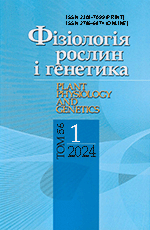Black walnut (Juglans nigra L.) is an important crop with a wide range of uses, one of the biological characteristics of which is its allopathic activity. Various organs of J. nigra contain juglone (5-hydroxy-1,4-naphthoquinone), a chemical compound with allopathic properties. In three-year studies, it was found that the amount of phenolic compounds in the fallen leaves of black walnut, which can have a phytotoxic effect on plants, ranged from 4.93 to 5.44 %. Analysis of the effect of water extracts of black walnut fallen leaves by biotests showed no effect on germination of winter wheat Novosmuglyanka variety seeds and low degree of inhibition of root system of its sprouts. At the same time, water extracts from fallen leaves of black walnut reduced germination and root length of pepper Velyten variety seeds up to 71—72 % compared to control. It was found that during the years of research, the damage of cereal weed (common bentgrass, Apera spica-venti (L.) P. Beauv.) by Alternaria in ecosystems with the presence of black walnut was significantly lower compared to similar plants in forest belts dominated by common oak. The results obtained show the prospects of using the natural naphthoquinone of the fallen leaves of the black walnut, juglone, both for the production of herbicides and for the protection of plants against diseases. Against the background of serious environmental threats caused by the widespread use of synthetic herbicides, the use of juglone can be an important environmental alternative to conventional herbicides. Therefore, the cultivation of black walnut in Ukraine is important for improving the environmental safety of agrophytocenoses.
Keywords: Juglans nigra L., Alternaria spp, black walnut, phenolic compounds, juglone, phytotoxicity, biotesting
Full text and supplemented materials
Free full text: PDFReferences
1. Shvydenko, A.Y. & Tsihankov, A.Y. (1978). Culture of black walnut. Lviv: Vishcha Shkola [in Ukrainian].
2. Hordiienko, N.M., Bondar, A.O. & Hordiienko, M.I. (2001). Introductions in the forests of Polissya and Forest-Steppe of Ukraine. Kyiv: Urozhay Publishing House [in Ukrainian].
3. Paudel, P., Satyal, P., Dosoky, N.S., Maharjan, S. & Setzer, W.N. (2013). Juglans regia and Juglans nigra, two trees important in traditional medicine: a comparison of leaf essential oil compositions and biological activities. Nat. Product Comm., 8, pp. 1481-1486. https://doi.org/10.1177/1934578X1300801038
4. Aboimova, A.N. & Polyakov, A.K. (2012). Growth and development of Juglans nigra L. in the South-East of Ukraine. Industrial Bot., 12, pp. 283-286. http://dspace.nbuv.gov.ua/ handle/123456789/67467
5. Valeriu-Norocel, N., Rѕdei, K., Vor, T., Bastien, J.-C., Brus, R., Ben№at, T., €odan, M., Cvjetkovic, B., Andraлev, S., La Porta, N., Lavnyy, V., Petkova, K., Peric, S., Bartlett, D., Hernea, C., P«stor, M., Mataruga, M., Podr«zskъ, V., Sfecia, V. & ћtefan№Нk, I. (2020). A review of black walnut (Juglans nigra L.) ecology and management in Europe. Trees, 34. https://doi.org/10.1007/s00468-020-01988-7
6. Tree Nuts. (Walnut polyphenols: structures and functions). (2009). Fukuda T. (Ed.). Tree Nuts: composition, phytochemicals, and health effects. Alasalvar C., Shahidi F. (Eds.). Nutraceutical Scence and Technology. New York: CRC Press Taylor & Francis Grup.
7. Islam, A.K.M.M. & Widhalm, J.R. (2020). Agricultural uses of juglone: opportunities and challenges. Agronomy, 10(10), 1500. https://doi.org/10.3390/agronomy10101500
8. Liu, S., Cheng, S., Jia, J. & Cui J. (2022). Resource efficiency and environmental impact of juglone in Pericarpium Juglandis: a review. Front. Env. Sci., 10. https://doi.org/10.3389/fenvs.2022.999059
9. Macias, F.A., Molinillo, J.M.G., Varela, R.M. & Galindo, J.C.G. (2007). Allelopathy - a natural alternative for weed control. Pest Manag. Sci., 63 (4), pp. 327-348. https://doi.org/10.1002/ps.1342
10. Lv, S.T., Du, W.X., Bai, S.M. & Chen, G. (2018). Insecticidal effect of juglone and its disturbance analysis in metabolic profiles of Aphis gossypii glover using 1H NMR-based metabonomics approach. Phytoparasitica, 46 (4), pp. 521-531. https://doi.org/10.1007/s12600-018-0682-6
11. Shang, X.F., Liu, Y.Q., Guo, X., Miao, X.L., Chen, C., Zhang, J.X., Xu, X.S., Yang, G.Z., Yang, C.J., Li J.C. & Zhang, X.S. (2018). Application of sustainable natural resources in agriculture: Acaricidal and enzyme inhibitory activities of naphthoquinones and their analogs against Psoroptes cuniculi. Sci. Rep. 8, 1609. https://doi.org/10.1038/s41598-018-19964-0
12. Yash, P. & Kalra, C.R.C. (2000). Handbook of reference methods for plant analysis. Corporate Blvd., NW, Boca Raton, FL 33431.
13. Hrodzynskyi, A.M. (1991). Alelopathy of plants and soil fatigue: izbr.tr. Kyiv: Naukova dumka [in Ukrainian].
14. Gilchrist-Saavedra, L., Fuentes-D«vila, G., MartНnez-Cano, C., Lopez-Atilano, R.M., Duveiller, E., Singh, R.P., Henry, M. & I. GarcНa, A. (2006). Practical guide to the identification of selected diseases of wheat and barley. Mexico, D.F.: CIMMYT.
15. Frak, E., Millard, P., Roux, X., Guillaumie, S. & Wendler, R. (2002). Coupling sap flow velocity and amino acid concentrations as an alternative method to 15N labeling for quantifying nitrogen remobilization by walnut trees. Plant Physiol., 130, pp. 1043-1053. https://doi.org/10.1104/pp.002139
16. Duran, A.G., Chinchilla, N., Molinillo, J.M.G. & Macias, F.A. (2019). Structure-activity relationship studies on naphthoquinone analogs. The search for new herbicides based on natural products. Pest Manag. Sci., 75 (9), pp. 2517-2529. https://doi.org/10.1002/ps.5442
17. Mykhalska, L.M., Zozulia, O.L., Hrytsev, O.A., Sanin, O.Y. & Schwartau, V.V. (2019). Distribution of species of Fusarium and Alternaria genera on cereals in Ukraine. Biosys. Diver., 27 (2), pp. 186-191. https://doi.org/10.15421/011925
18. Schiro, G., Verch G., Grimm, V. & Muller, M.E.H. (2018). Alternaria and Fusarium Fungi: differences in distribution and spore deposition in a topographically heterogeneous wheat Field. J. Fungi (Basel), 24, 4 (2), 63. https://doi.org/10.3390/jof4020063
19. Hoffmann, A., Lischeid, G., Koch, M., Lentzsch, P., Sommerfeld, T. & Muller, M.E.H. (2021). Co-cultivation of Fusarium, Alternaria, and Pseudomonas on wheat-ears affects microbial growth and mycotoxin production. Microorganisms, 20, 9 (2), p. 443. https://doi.org/10.3390/microorganisms9020443
20. Liu, L., Kuang, Y., Yan, F., Li, S., Ren, B., Gosavi, G., Spetz, C., Li, X., Wang, X., Zhou, X. & Zhou, H. (2021). Developing a novel artificial rice germplasm for dinitroaniline herbicide resistance by base editing of OsTubA2. Plant Biotechnol. J., 19 (1), pp. 5-7. https://doi.org/10.1111/pbi.13430
21. Schwartau, V.V. & Mykhalska, L.M. (2022). Herbicide-resistant weed biotypes in Ukraine. Rep. Nat. Acad. Sci. Ukraine, 6, pp. 85-94 [in Ukrainian]. https://doi.org/ 10.15407/dopovidi2022.06.085
22. Mykhalska, L.M. & Schwartau, V.V. (2022). Identification of acetolactate synthase resistant Amaranthus retroflexus in Ukraine. Reg. Mech. Biosyst., 13 (3), pp. 231-240. https://doi.org/10.15421/022230
